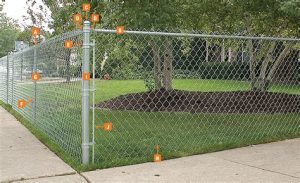Learn about fencing permits, state-specific requirements, common regulations, the application process, and the consequences of not obtaining a permit.When considering a new fencing project, understanding the associated permit requirements is crucial to ensure compliance with local regulations. A fencing permit serves as a formal approval from your municipality, allowing you to build or modify a fence on your property. However, the specific requirements for obtaining a permit can vary significantly from state to state, with each jurisdiction enforcing its own set of rules, restrictions, and guidelines. This blog post will explore the key aspects of fencing permits, including what they are, the different requirements across states, common restrictions you may encounter, and the important steps to take when applying for a permit. We’ll also discuss the potential consequences of failing to secure the necessary approvals. Whether you’re a homeowner planning a new fence or a contractor guiding clients, understanding these regulations will help you avoid legal pitfalls and keep your project on track.
What is a fencing permit?
A fencing permit is an official authorization required by local governments before an individual can construct a fence on their property. This requirement is in place to ensure that homeowners comply with zoning laws, building codes, and safety regulations. The intention behind the permit process is to protect property rights, neighborhood aesthetics, and safety standards.
Each state and municipality may have different regulations and requirements for obtaining a fencing permit. In many cases, the need for a permit depends on factors such as the height, type of fencing material, and the location of the fence within the property lines. Some areas may have strict guidelines that dictate how fences must be constructed, while others may be more lenient.
Homeowners are encouraged to check with their local planning or building department to understand the specific rules and regulations that apply to their area. Failing to acquire a fencing permit when required can result in fines, mandatory removal of the fence, and potential legal disputes with neighbors.
Different fencing permit requirements by state
When it comes to erecting a fence on your property, one key consideration is whether you need a fencing permit. The requirements for obtaining a fencing permit can vary significantly depending on the state you reside in. Understanding these differences is critical to ensure you comply with local regulations and avoid potential fines.
| State | Permit Required? | Height Restrictions | Additional Regulations |
|---|---|---|---|
| California | Yes | 6 feet for residential | Must adhere to local zoning laws |
| Texas | No | Varies by county | No specific state-wide regulations |
| Florida | Yes | 4 feet in front yard, 6 feet in backyard | Must maintain visibility at intersections |
| New York | Yes | 6 feet for residential | May require easement consideration |
As shown in the table above, while some states like Texas may not require a permit at all, others, such as California and Florida, have specific fencing permit requirements and height restrictions that must be adhered to. Additionally, some areas may have local ordinances that impose further regulations, making it imperative to check with your local municipality before starting your fencing project.
In summary, it is essential to familiarize yourself with the fencing permit requirements in your state, as they can affect not only the legality of your fencing installation but also community aesthetics and property value.
Common restrictions and regulations for fencing
When considering a fencing permit, it’s crucial to understand the common restrictions and regulations that may apply in your area.
- Height Limitations: Many municipalities impose height restrictions on fences. A typical limit might be between 4 to 6 feet, depending on whether the fence is in the front or back yard.
- Material Usage: Restrictions may apply regarding the materials you can use to build your fence. For example, some areas may prohibit the use of barbed wire or specify that only certain types of wood or vinyl are permissible.
- Setback Requirements: Some areas require fences to be built a certain distance away from property lines. This is often referred to as a setback requirement, and failure to comply can lead to fines or the requirement to remove or alter the fence.
- Design Regulations: In certain neighborhoods, especially those with Homeowners’ Associations (HOAs), there may be specific design guidelines that dictate the appearance of your fence, including color, style, and landscaping around it.
- Neighborhood Covenants: Some homeowners live under covenants that set standard practices for home and yard improvements, which may include rules on fencing.
It’s essential to thoroughly research your local laws and regulations regarding fencing permits before starting your project. Ensure that you’ve checked with your city or county building department to understand what is allowed and avoid any setbacks.
Additionally, people often overlook that obtaining a proper fencing permit not only keeps your project compliant but also accommodates future property disputes with neighbors. Understanding these common restrictions helps you to create a fence that is both functional and reflective of your property’s aesthetics.
Staying informed about local fencing regulations can save you time, money, and potential legal challenges. Before beginning any fencing project, always consult local guidelines or contact a professional to ensure you are fully compliant.
How to apply for a fencing permit
Applying for a fencing permit can be a straightforward process if you understand the necessary steps and requirements. First and foremost, it’s essential to check with your local zoning office or building department to understand the specific requirements for your area. Each state, and sometimes even different municipalities within a state, may have varying regulations.
- Research Local Regulations: Visit your local government’s website or contact them directly to gather information regarding fencing permits.
- Prepare Required Documents: You may need to submit documents such as a site plan, property surveys, or photographs of the intended fencing location.
- Complete the Application: Fill out the fencing permit application form accurately, ensuring all requested information is provided.
- Pay Fees: Be prepared to pay any application fees, which can vary by state and local jurisdiction.
- Submit the Application: Submit your application either in person or online, depending on your local government’s process.
Once you submit your application, it may take several days to process. Be sure to follow up with the relevant department to check on the status of your permit. If your application is approved, ensure that you adhere to all regulations outlined in the permit to avoid any potential fines or issues in the future.
Consequences of not obtaining a fencing permit
When it comes to installing a fence, not obtaining the proper fencing permit can lead to a multitude of consequences that can complicate both your project and your life. Each state and municipality may have specific regulations surrounding fencing, and ignorance of these laws can inadvertently put you in a challenging situation.
One of the most immediate consequences is the risk of receiving fines. Local authorities may impose penalties that can range from minimal amounts to significant fees, especially if a violation is flagged during property inspections or if complaints are filed by neighbors. In some cases, the fines can be substantial, creating an unexpected financial burden.
Additionally, failing to secure a fencing permit can result in the need to remove or modify the installed fence. You might face a demand from local officials to dismantle the structure if it doesn’t comply with zoning laws or property regulations. This not only increases costs due to extra labor and materials but may also delay your project significantly.
In extreme cases, complications can lead to property disputes. Neighbors may contest the placement or height of your fence, especially if it affects their property rights or violates local codes. Such disputes can strain relationships and might even lead to legal action, adding more stress and cost to your fencing project.
In summary, while it may seem tempting to skip the fencing permit process to save time or money, the potential penalties, including fines, removal of the structure, and even legal disputes, far outweigh any immediate convenience. It’s always best to ensure that you are compliant with your local regulations prior to constructing a fence.
Frequently Asked Questions
What are fencing permits and why are they required?
Fencing permits are legal approvals required by local governments before erecting a fence. They ensure that the fence complies with zoning laws, property lines, and safety regulations.
Do all states have the same fencing permit requirements?
No, fencing permit requirements vary by state and even by local municipalities. It’s essential to check the specific regulations in your area before starting a fencing project.
What factors can affect the need for a fencing permit?
Factors include the height and type of fence, proximity to property lines, and the intended use of the fence. Some areas may waive the requirement for certain types of fences, like garden fences.
How can I find out the fencing permit requirements for my state?
You can find this information by visiting your state or local government’s planning or zoning office website, or by contacting them directly for guidance.
What are the consequences of not obtaining a fencing permit?
Failing to obtain a fencing permit can result in fines, orders to remove the fence, or legal disputes with neighbors over property lines.
Are there specific documents I need to submit for a fencing permit?
Typically, you will need to submit a site plan, a description of the proposed fence, and sometimes photographs or drawings. Requirements can vary, so check local guidelines.
Is the process for obtaining a fencing permit lengthy?
The length of the process can vary widely by location. In some areas, permits can be approved quickly, while in others, it may take weeks or even months depending on zoning laws and review processes.





